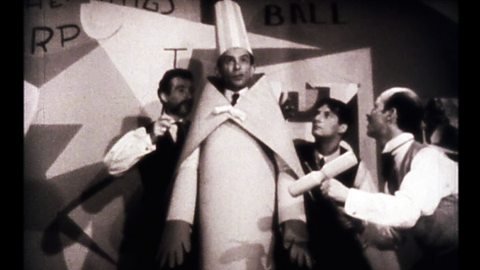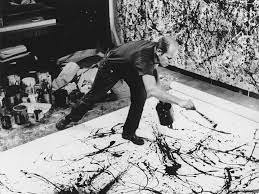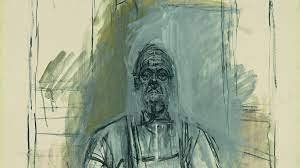A look back at ‘The Experiment’
By Karim Naamani
Earlier this year, Lebanese artist Simon Mhanna collaborated with Zalfa Halabi Art Gallery in a live painting performance exhibition titled The Experiment, which marked important milestones for both parties. In the artist’s case, it was the production of his largest scale painting to date, and in the case of the latter, a celebration of their one-year anniversary.
True to its title, The Experiment attempted to form an alternative way to paint, produce, and curate an exhibition. On March 30th 2023, the space was radically transformed into a makeshift studio, retrofitted with 39 canvases across three sides of the gallery. Drenched in an atmospheric blue color, the scene was set for the artist to begin his experimentation. Inside with him was a perched video camera operated by photographer and videographer Joya Simon, to capture the event unfold form start to finish.
The exhibition wall text read as follows:
A look inside the gallery transformed into a studio with 39 canvases covering the wall surfaces of the interior.
THE EXPERIMENT, March 2023, ZALFA HALABI ART GALLERY.
Photo credit: WASSIM RAHHAL.
For three hours straight, the artist paced between the walls of the gallery-studio, attacking them with quick, bold strokes. Varying between brushstrokes and palette knife smears, Mhanna’s gestures seemed to affirm an intentionality in his work – a commitment to stream of consciousness painting. Mhanna had to improvise as he goes, while onlookers and passersby watched from the outside, peering into the artistic process of creation that usually remains hidden from the public eye.
People in the crowd holding up their phones to record the begging of the THE EXPERIMENT.
THE EXPERIMENT, March 2023, ZALFA HALABI ART GALLERY.
Photo credit: WASSIM RAHHAL.
Performance art holds a long history that traces itself back to the Dada movements. Starting in 1916 at the Cabaret Voltaire in Zurich, Switzerland, Dadaism philosophy was radically anti-capitalist, anti-bourgeois, and anti-art. They focused less on aesthetic enjoyment and rational, logical thought, and used collage, performance, and the readymade in their art production. Building on that, Mhanna’s intentions followed suit: he painted chaotically from wall to wall, never keeping himself focused in one place for an extended period of time.
Still of Dada Artist Hugo Ball in costume at the Cabaret Voltaire. From Dada, 1967. Documentary directed by Great Deses.
It wasn’t until American critic Harold Rosenberg coined the term ‘Action Painting’ that performance art specifically became its own artistic practice. Rosenberg wrote of the “canvas appearing as an arena in which to act… what was to go on the canvas was not a picture but an event.” He called for a radical shift in painting, one that centers around the artist, while formal qualities and elements became secondary. In keeping with American Action painting tradition, among the tools that Mhanna used was spraying. This technique recalls that iconic drip made famous by Jackson Pollock. Similar to action painters, Mhanna’s work focused on the present moment and the time constraint he had to complete his work on.
Jackson Pollock, 1950.
Photo credit: Hans Namuth Estate, Courtesy center for Creative Photography. .
Artists have always held a near mythical stance in comparison to everyday people. They are often understood to be unique, genius, and creative individuals in our society. This understanding has its roots deep within art history. The painter exists outside the public eye. Isolated in their studios, they toil away at their work to create dialogues that speak of their innermost desires. The Experiment pushed back on that narrative, it brought the artistic process into the exhibition space and made it the center piece. To watch Mhanna paint grounded his position as an artist.
Performing artist Simon Mhanna, painting inside the gallery space.
THE EXPERIMENT, March 2023, ZALFA HALABI ART GALLERY.
Photo credit: WASSIM RAHHAL.
Mhanna is no stranger to portraiture. The bulk of his work is largely composed of various portraits, most of which stare unflinchingly back at the viewer. Painting through drawing to define depth, he conveys various emotions through application of color and gestural line work. His most recent portraits, like that of The Experiment, have mostly been monochromatic faces defined by their parts that are never completed by the contour of a face. Instead, they float in the canvas space keeping their signature stare.
By compiling 39 canvasses across the gallery-studio, Mhanna seers into each one an array of lines, once again searching, drawing, for the right place. Some contain his iconic spiraling, deadpan eyes that recall thework of Alberto Giacometti.
Alberto Giacometti c.1965.
Rita, oil on canvas, 70 x 50.2 cm from the collection at the Foundation Giacometti in Paris.
For his final touches, Mhanna drops the black paint that he had been using all night and begins to splash blue paint onto the faces, breaking through the monotone and creating new contrasts. This radical decision comes as a response to the aquarium feel of the space. Blue is a cool color that usually gives off feelings of isolation and loneliness. This decision reinforces the portraits’ gazes as distant and melancholic. Perhaps it is the fact that Mhanna was locked in the gallery-studio that he drew inspiration from his surroundings and painted gazes from people in the audience. In real time, he recognizes himself being objectified and applies that onto the canvas. There is a dynamic feedback loop where the act of looking takes center stage. The viewer isn’t just looking at the performer anymore, they are looking at themselves through his paintings.
The completion of The Experiment is an important part of the performance. After Mhanna finished painting, viewers were permitted to enter the space and feast their eyes on his labor. In doing so, they are able to reconcile the “completed” artworks with the performance of painting. The audience is forced to form new connections with the work than if they had only been displayed outright. The ephemeral quality of the performance reveals the importance of memory, choice, and action. Watching The Experiment means being an active participant in fleeting moments as they come.
Another important aspect to call attention to, is how The Experiment is situated locally. Lebanon’s contemporary art scene is best understood to have started with direct and political public art, including performance pieces. Starting with Ziad Abillama’s installation piece Where Are We? (1992) an installation piece at the Saint Balech beach in Antelias. and The First Sanayeh Plastic Arts Meeting (1995) a public art event that brought together 38 local artists from various backgrounds
View of an installation by Ziad Abillama on a beach c. 1992.
Photography by Catherine Cattaruzza.
Using hybrid, multimedia practices these artists dealt with critiquing state narratives and the construction of the truth. With the rise of Lebanon’s contemporary art production into the international scene, a divide rose between these artists and others whose works utilized more traditional mediums like painting and sculpture. Mhanna’s The Experiment looks back on that tradition and takes it to another place. Instead of being overtly political, it is instead focused more on the form. The painting performance is more interested in play and improvisation and what can come out of that.
Onlookers watching artist Simon Mhanna in action inside the gallery space.
THE EXPERIMENT, March 2023, ZALFA HALABI ART GALLERY.
Photo credit: WASSIM RAHHAL.
After completing the performance, the 12-meter-long painting was re-arranged to be displayed as 39 separate canvases. Each acquired piece would leave behind an empty space. The result: a fragmented image that turned the whole and its pieces into abstract paintings. The body, as well as the paintings, can never be whole after separation. This way, each canvas carried with it the spirit and the story of The Experiment. The importance of the factor of time and space was embodied in each work and preserved the idea of the performance. Today, the fragments exist scattered across the globe, in New York, Texas, Argentina, Hawaii, Martinique and Beirut.
The last paragraph of the exhibition wall text read as follows:
Selection of pieces from the “Front Wall”




















